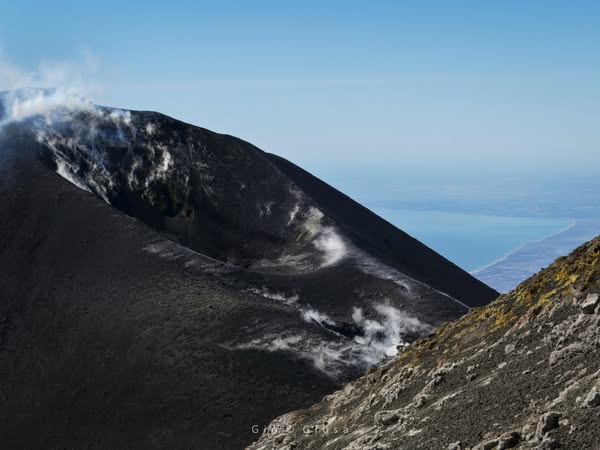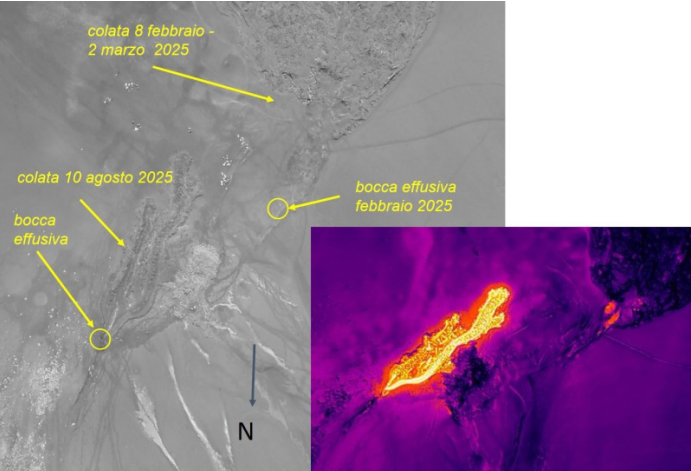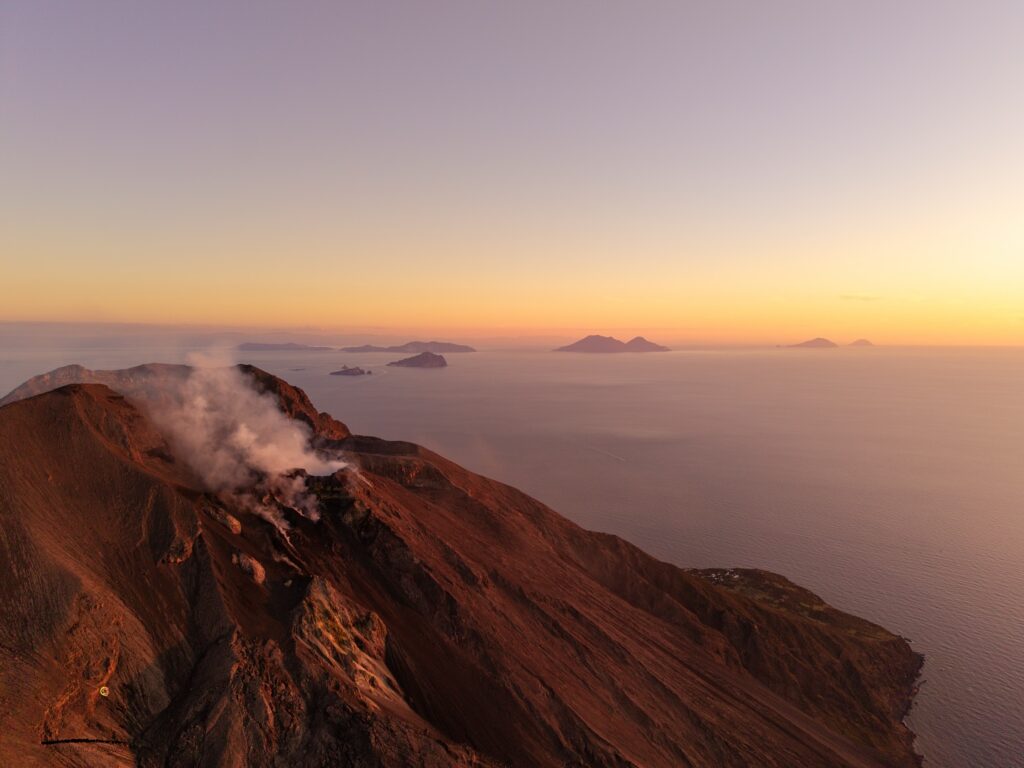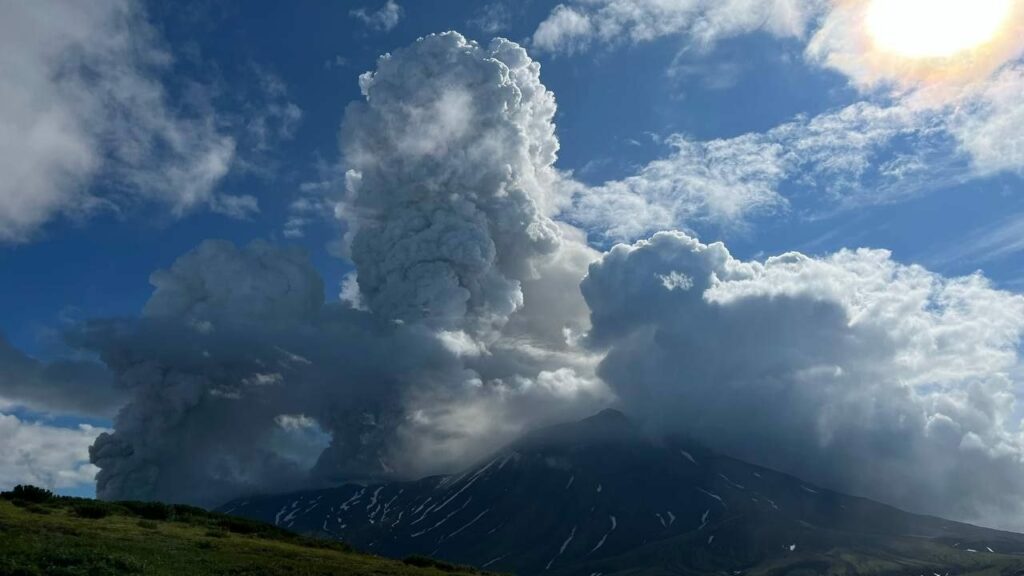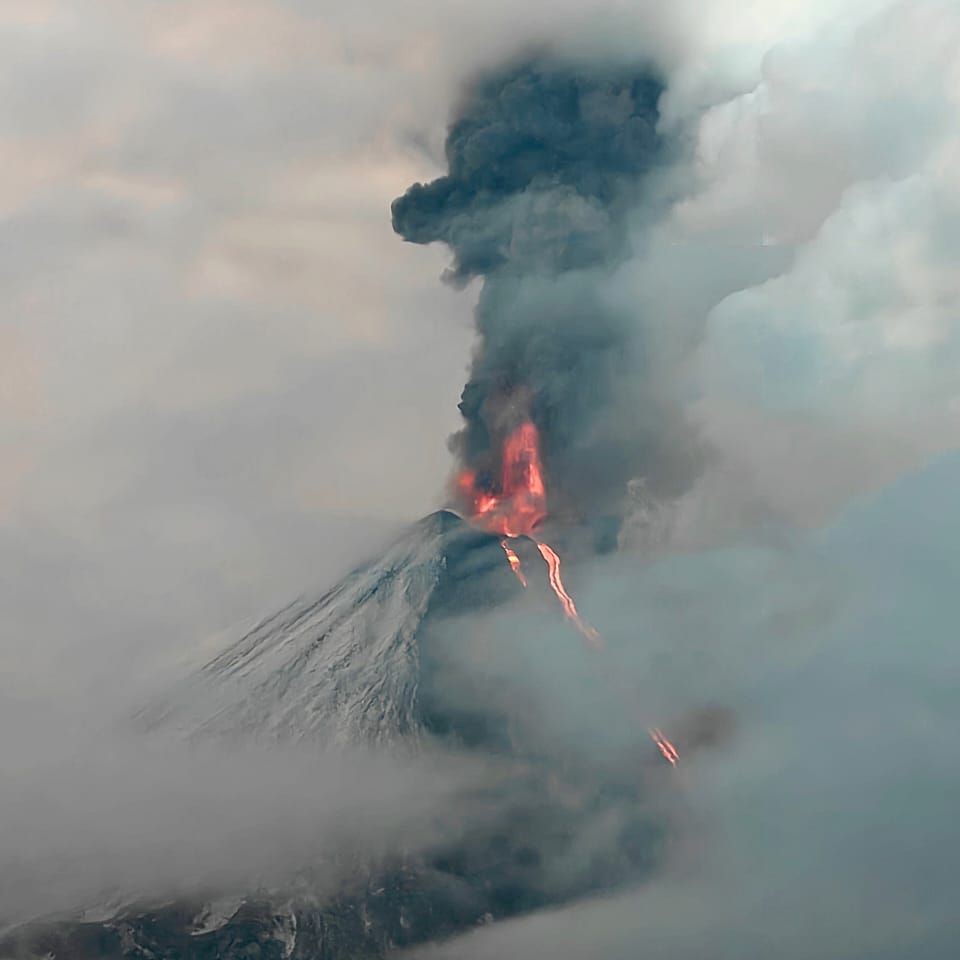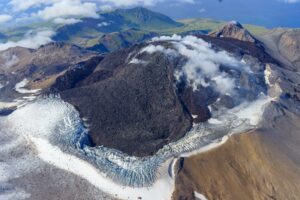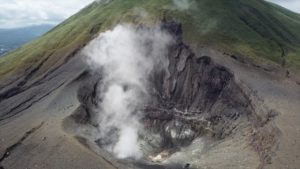August 13 , 2025.
Indonesia , Marapi :
ERUPTION OF MARAPI VOLCANO, WEST SUMATRA, AUGUST 12, 2025, 8:39 WIB
Marapi Volcano (2,891 meters above sea level) is located in the province of West Sumatra. Mount Marapi’s activity level has been Level II (WASPADA) since December 1, 2024.
Since December 3, 2023, Mount Marapi has been erupting intermittently, with a fluctuating downward trend. On August 12, 2025, two eruptions occurred. The 8:39 WIB eruption, recorded by a seismograph, produced a relatively tall eruptive column. It reached a maximum amplitude of 30.4 mm and lasted 34 seconds. The eruptive column observed from the observation post located 1,600 meters above the summit was white to gray, intense and oriented towards the northeast.
This morning’s eruption corresponded to a release of pressure from fluids accumulated within Mount Marapi, as also evidenced by the increase in the number of deep volcanic earthquakes (VA) the previous day and a trend toward inflation of the volcanic body since mid-June 2025, which has rendered the volcanic environment unstable. Vigilance is therefore required, as the volcano remains vulnerable to future eruptions.
The Center for Volcanology and Geological Hazard Mitigation (PVMBG), the Geological Agency, has maintained the activity level of Mount Marapi at Level II (WASPADA). The main recommendation is that local residents, mountaineers, visitors, and tourists refrain from entering the Verbeek crater and from carrying out any activity within a 3 km radius.
Source : PVMBG
Photo : Screenshot via Vulcaniya / FB .
Italy / Sicily , Etna :
WEEKLY BULLETIN, from August 4, 2025 to August 10, 2025. (Publication date: August 12, 2025)
ACTIVITY SUMMARY
Based on monitoring data, the following elements are highlighted:
1) VOLCANOLOGICAL OBSERVATIONS: Effusive activity from an eruptive fissure at the base of the Bocca Nuova crater, moderate and episodic Strombolian activity at the Southeast crater, and degassing at the Bocca Nuova crater, Voragine, and the Northeast crater.
2) SEISMOLOGICAL: Absence of seismic activity due to fracturing with Ml >=2.0. Average amplitude of volcanic tremor is medium to low.
3) INFRASOUND: Low infrasound activity located at the Northeast and Southeast craters.
4) GROUND DEFORMATIONS: No significant changes were reported in the time series from the inclinometer and GNSS networks. A very small transient variation was recorded on the strain gauge in the early hours of August 10.
5) GEOCHEMISTRY: SO2 fluxes at a low level. CO2 fluxes from the soil (EtnaGas network) are slightly increasing, but still at medium to low values.
Dissolved CO2 in groundwater (EtnaAcque network): No update.
Helium isotope ratio at peripheral sites: The latest data from August 5 are high.
6) SATELLITE OBSERVATIONS: Thermal activity observed by satellite in the summit area was generally low, with some moderate thermal anomalies consistent with the eruptive activity of August 10, 2025.
VOLCANOLOGICAL OBSERVATIONS
During the observation period, Mount Etna’s volcanic activity was monitored through image analysis from the surveillance camera network of the National Institute of Geophysics and Volcanology, Osservatorio Etneo (INGV-OE), and through surveys carried out in the summit area by INGV personnel on August 10 and 11.
During the week of volcanic activity characterized by low-intensity explosive activity at the Southeast Crater (SEC) and variable-level degassing in the remaining craters, Mount Etna entered an effusive phase late in the evening of August 9.
Effusive activity in the southern area of Bocca Nuova in February-March 2025 and August 2025. Drone image with inset at bottom right of the active lava flow on August 10.
Specifically, the effusive activity was subterminal from an eruptive fracture located between Bocca Nuova and the Southeast Crater, at an altitude of approximately 3,100 m above sea level, with an approximate north-south direction and an extension of approximately 33 m. The slow-flowing lava flow developed with a front reaching an altitude of 3,700 m above sea level. The effusive activity ended late on August 10.
During the week, the Southeast Crater was characterized by moderate explosive activity, fueled by two vents, with ejected lava fragments falling back onto the crater rim and sporadically onto the cone slopes. This activity was accompanied by weak ash emissions that quickly dispersed in the summit area (the activity began on July 21).
The southern area of Bocca Nuova was affected by effusive activity, with vents opening between 3,000 and 3,100 m above sea level. This activity developed in February with a lava flow that began on February 8, 2025, and ended on March 2 with the front that interrupted the « Altomontana » track. The second episode of effusive activity began on August 9 and ended on August 10..
Source : INGV
Photos : Gio Giusa , INGV
Italy , Stromboli :
WEEKLY BULLETIN, from August 4, 2025 to August 10, 2025. (Publication date: August 12, 2025)
ACTIVITY SUMMARY
Based on monitoring data, the following elements are highlighted:
1) VOLCANOLOGICAL OBSERVATIONS: Ordinary eruptive activity of medium frequency in the northern area of the crater and low frequency in the central-southern area. The average total frequency was 10 events/hour, with low intensity and episodes of medium intensity in the northern area and low intensity in the central-southern area.
Continuous eruptive activity within the large crater structure occupying the central-southern area and with a variable regime in the northern area.
2) SEISMOLOGICAL: The monitored seismic parameters show no significant variation. 3) GROUND DEFORMATION: No significant changes are detected in the ground deformation data.
4) GEOCHEMISTRY: Average and increasing SO2 flux.
Soil CO2 flux in the Pizzo area (STR02): Due to technical issues, no updates are available. The latest recorded values (August 3) are average to high. The C/S ratio in the plume remains at average to high values.
Dissolved helium isotope ratio (R/Ra) in the thermal aquifer: No update. The latest values (July 9) remain high.
Soil CO2 flux in the Scari area remains high.
5) SATELLITE OBSERVATIONS: Thermal activity observed by satellite in the summit area was generally low.
VOLCANOLOGICAL OBSERVATIONS
During the observation period, Stromboli’s eruptive activity was characterized by analyzing images recorded by the INGV-OE surveillance cameras located at an altitude of 190 m and at Punta dei Corvi (SCT-SCV and SPCT, respectively). Explosive activity was mainly produced by four eruptive vents located in the North Crater area and by at least two vents located in the Central-South Crater area.
The eruptive activity observed in the North (N) Crater area was produced by four active vents, with eruptive products consisting mainly of coarse materials (bombs and lapilli). The explosions were of low intensity (the eruptive products reached a height of less than 80 m) and occasionally of medium intensity (the height of the products ranged from 80 to 150 m). The average explosion frequency was about 8.5 events per hour. In the South-Central (SC) area, explosive activity remains modest, with explosions containing mainly fine materials with low intensity. The average explosion frequency was about 1.5 events/hour. During the observation period, Strombolian activity was associated with spattering in the North and South-Central areas. Specifically, in the North area, this activity, produced by the two chimneys N1 and N2, occurs at a variable rate, while in the large crater occupying the South-Central area, the rate is continuous and sometimes intense (e.g., on August 5).
Source : INGV
Photo : Stromboli stati d’animo / Sebastiano Cannavo .
Kamchatka , Krasheninikov :
KRASHENINNIKOV VOLCANO (CAVW #300190)
54.6 N, 160.27 E;
Elevation 1856 m (6088 ft)
Aviation Colour Code is ORANGE
An explosive-effusive eruption of the volcano continues. Lava flows have filled the crater of the Northern сone of the volcano and flow in several branches onto its northwestern slope; at the foot of the cone, in the caldera of the volcano, lava flow deposits have formed with an area of about 1 square kilometer. Volcanic bombs are ejected along with gas-ash material from numerous vents on the fissure that cuts through the crater and the northwestern slope of the Northern cone of the volcano. An ash emission from the Northern cone crater and an effuse of a lava flow to its northwestern flank continues. Satellite data by KVERT showed a large bright thermal anomaly over the volcano.
Source : Kvert
Photo : Liza Sandalova via Vulcaniya / FB.
Kamchatka , Klyuchevskoy :
VOLCANO AVIATION OBSERVATION NOTICE (VONA)
Issued: August 13, 2025
Volcano: Klyuchevskoy (CAVW No. 300260)
Current Aeronautical Color Code: ORANGE
Previous Aeronautical Color Code: Orange
Source: KVERT
Notice Number: 2025-69
Volcano Location: N 56° 3 min E 160° 38 min
Area: Kamchatka, Russia
Summit Elevation: 4,750 m (15,580 ft)
Volcanic Activity Summary:
A summit explosive-effusive eruption of the volcano continues. A move of lava flows and ash emission from summit crater of the volcano continues. Activity of the volcano has decreased significantly. Satellite data by KVERT showed explosions sent ash up to 5-5.5 km a.s.l., and ash plume is extending for 302 km to the southwest of the volcano. The ash cloud 205×85 km in size continue to move to the southwest of the volcano on the high about 7-7.5 km a.s.l.
An extrusive-effusive eruption of the volcano continues. The danger of ash explosions up to 10 km (32,800 ft) a.s.l. remains. Ongoing activity could affect international and low-flying aircraft.
Volcanic cloud height:
5000-5500 m (16400-18040 ft) AMSL Time and method of ash plume/cloud height determination: 20250813/0230Z – Himawari-9 14m15
Other volcanic cloud information:
Distance of ash plume/cloud of the volcano: 302 km (188 mi)
Direction of drift of ash plume/cloud of the volcano: SW / azimuth 219 deg
Time and method of ash plume/cloud determination: 20250813/0230Z – Himawari-9 14m15
Source : Kvert
Photo :V. Levin and G. Kan from Bogdanovich Glacier, August 7, 2025 via vulcaniya / FB.


